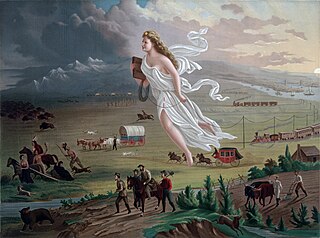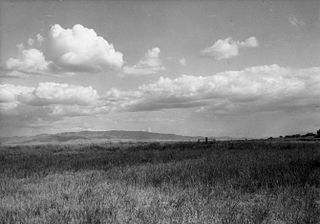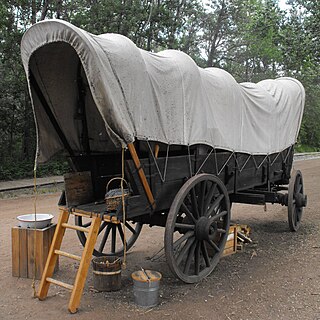
Manifest destiny was a phrase in the 19th-century United States that represented the belief that American settlers were destined to expand westward across North America, and that this belief was both obvious ("manifest") and certain ("destiny"). The belief was rooted in American exceptionalism and Romantic nationalism, implying the inevitable spread of the Republican form of governance. It was one of the earliest expressions of American imperialism in the United States of America.

The American frontier, also known as the Old West, and popularly known as the Wild West, encompasses the geography, history, folklore, and culture associated with the forward wave of American expansion in mainland North America that began with European colonial settlements in the early 17th century and ended with the admission of the last few contiguous western territories as states in 1912. This era of massive migration and settlement was particularly encouraged by President Thomas Jefferson following the Louisiana Purchase, giving rise to the expansionist attitude known as "manifest destiny" and historians' "Frontier Thesis". The legends, historical events and folklore of the American frontier have embedded themselves into United States culture so much so that the Old West, and the Western genre of media specifically, has become one of the defining features of American national identity.

A wagon train is a group of wagons traveling together. Before the extensive use of military vehicles, baggage trains followed an army with supplies and ammunition.

Fort Hall was a fort in the Western United States that was built in 1834 as a fur trading post by Nathaniel Jarvis Wyeth. It was located on the Snake River in the eastern Oregon Country, now part of present-day Bannock County in southeastern Idaho. Wyeth was an inventor and businessman from Boston, Massachusetts, who also founded a post at Fort William, in present-day Portland, Oregon, as part of a plan for a new trading and fisheries company. In 1837, unable to compete with the powerful British Hudson's Bay Company, based at Fort Vancouver, Wyeth sold both posts to it. Great Britain and the United States both operated in the Oregon Country in these years.

The Treaty with the Kalapuya, etc., also known as the Kalapuya Treaty or the Treaty of Dayton, was an 1855 treaty between the United States and the bands of the Kalapuya tribe, the Molala tribe, the Clackamas, and several others in the Oregon Territory. In it the tribes were forced to cede land in exchange for promised permanent reservation, annuities, supplies, educational, vocational, health services, and protection from ongoing violence from American settlers. The treaty effectively gave over the entirety of the Willamette Valley to the United States and removed indigenous groups who had resided in the area for over 10,000 years. The treaty was signed on January 22, 1855, in Dayton, Oregon, ratified on March 3, 1855, and proclaimed on April 10, 1855.

A covered wagon, also called a prairie wagon, whitetop, or prairie schooner, is a horse-drawn or ox-drawn wagon with a canvas top used for transportation or hauling. The covered wagon has become a cultural icon of the American West.
Meek Cutoff was a horse trail road that branched off the Oregon Trail in northeastern Oregon and was used as an alternate emigrant route to the Willamette Valley in the mid-19th century. The road was named for frontiersman Stephen Meek, who was hired to lead the first wagon train along it in 1845. The journey was a particularly hard one, and many of the pioneers lost their lives.

Oregon pioneer history (1806–1890) is the period in the history of Oregon Country and Oregon Territory, in the present day state of Oregon and Northwestern United States.
The discovery doctrine, or doctrine of discovery, is a disputed interpretation of international law during the Age of Discovery, introduced into United States municipal law by the US Supreme Court Justice John Marshall in Johnson v. McIntosh (1823). In Marshall's formulation of the doctrine, discovery of territory previously unknown to Europeans gave the discovering nation title to that territory against all other European nations, and this title could be perfected by possession. A number of legal scholars have criticized Marshall's interpretation of the relevant international law. In recent decades, advocates for Indigenous rights have campaigned against the doctrine. In 2023, the Vatican formally repudiated the doctrine.

Expansionism refers to states obtaining greater territory through military empire-building or colonialism.

American pioneers were European American, Asian American and African American settlers who migrated westward from the Thirteen Colonies and later the United States of America to settle and develop areas of the nation within the continent of North America that were once sometimes even inhabited by indigenous tribes.

Westward the Course of Empire Takes Its Way is a 20-by-30-foot painted mural displayed behind the western staircase of the House of Representatives chamber in the United States Capitol Building. The mural was painted by Emanuel Gottlieb Leutze in 1861 and symbolizes Manifest Destiny, the belief that the United States was destined for Western exploration and expansion originating from the initial colonies along the Atlantic seaboard to the Pacific Ocean. A study measuring 33+1⁄4 by 43+3⁄8 inches hangs in the Smithsonian American Art Museum.

The Last Drop of Water is a 1911 American short silent Western film directed by D. W. Griffith and starring Blanche Sweet. Three known prints of the film survive. It was filmed in the San Fernando desert as well as Lookout Mountain, California. The film was considered the "most ambitious film made by Griffith during the California trip of 1911" before the Biograph company moved back to New York. It was filmed on or between the 14 May and May 20, 1911. It was reissued by Biograph August 13, 1915.

The Discovery of America is a large marble sculptural group, created by Luigi Persico, which adorned the front of the east façade of the United States Capitol building from 1844 to 1958, before being put into storage.
In the history of the American frontier, pioneers built overland trails throughout the 19th century, especially between 1829 and 1870, as an alternative to sea and railroad transport. These immigrants began to settle much of North America west of the Great Plains as part of the mass overland migrations of the mid-19th century. Settlers emigrating from the eastern United States did so with various motives, among them religious persecution and economic incentives, to move from their homes to destinations further west via routes such as the Oregon, California, and Mormon Trails. After the end of the Mexican–American War in 1849, vast new American conquests again encouraged mass immigration. Legislation like the Donation Land Claim Act and significant events like the California Gold Rush further encouraged settlers to travel overland to the west.
The West as America, Reinterpreting Images of the Frontier, 1820–1920 was an art exhibition organized by the Smithsonian American Art Museum in Washington, D.C. in 1991, featuring a large collection of paintings, photographs, and other visual art created during the period from 1820 to 1920 which depicted images and iconography of the American frontier. The goal of the curators of The West as America was to reveal how artists during this period visually revised the conquest of the West in an effort to correspond with a prevailing national ideology that favored Western expansion. By mixing New West historiographical interpretation with Old West art, the curators sought not only to show how these frontier images have defined American ideas of the national past but also to dispel the traditional beliefs behind the images.

John Gast was a Prussian-born American painter and lithographer.

Western American Art includes artistic work which depicts the subjects related to the Western American region, and was treated as impoverished, unwanted and unworthy art before the twentieth century, during which period it achieved respectability as a rewarding region for studying. The term holds a characteristic of narration that is different from the Modern art which focuses on abstraction. For the narration, Western American art focuses on subject than style. Considering as a national art, the subjects are distinct from the European art, namely, there is no elements from other region like Europe. Cowboys and Indians are two well-known subjects and they consist the important part of artistic work of Western American art, demonstrating the daily life and activities of cowboys and American Indian in western American.

The Progress of Civilization is a marble pediment above the entrance to the Senate wing of the United States Capitol building designed by the sculptor Thomas Crawford. An allegorical personification of America stands at the center of the pediment. To her right, a white woodsman clears the wilderness inhabited by a Native American boy, father, mother, and child. The left side of the pediment depicts a soldier, a merchant, two schoolchildren, a teacher with her pupil, and a mechanic.
Circle the wagons is an English language idiom which may refer to a group of people who unite for a common purpose. Historically the term was used to describe a defensive maneuver which was employed by Americans in the 19th century. The term has evolved colloquially to mean people defending each other.














